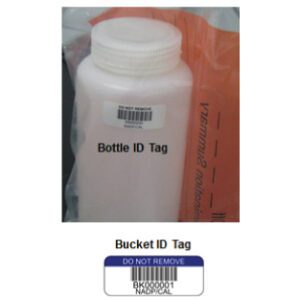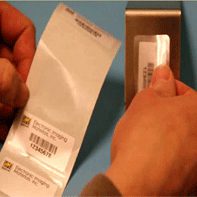Barcode labels are everywhere—on products at the grocery store, packages we receive, and equipment used in businesses. But have you ever wondered what barcode labels are made of?
There are many types of label materials, each made for specific uses. Choosing the right barcode label is important because it can affect how well it sticks to a surface, how long it lasts, and how well it shows the printed information. As such, working with a Label Expert to ensure you pick the right label type is important. Keep reading as we explore different types of barcode label materials and help you understand which one is best for your needs.

Types of Label Material
Barcode labels can be made from a variety of materials. Often, material suppliers will not completely divulge the content of their face stocks. Each type has different qualities, so picking the right one depends on where and how it will be used. Here are the most common types of label materials:
1. Paper Labels
Paper labels are the most basic and affordable type of barcode label. They work well for simple uses, like product packaging, shipping labels, or indoor storage. These labels are easy to print and apply but aren’t very durable. Paper labels can tear easily and are not waterproof or resistant to high temperatures. They’re best for short-term uses where durability isn’t a big concern.
2. Polyester (PET) Labels
Polyester, also known as PET, is a strong and smooth material commonly used for barcode labels that need to be long-lasting and tough. PET labels are resistant to high temperatures, moisture, and chemicals, making them ideal for harsher environments, such as industrial settings or outdoor use. Polyester labels have a shiny surface on the adhesive side and are known for their excellent print quality. These labels are a great choice when durability and clarity are essential.
3. Polypropylene (PP) Labels
Polypropylene labels, or PP labels, offer a balance between flexibility and durability. They are resistant to scratches, chemicals, and moisture, making them a good choice for a variety of indoor and outdoor uses. Unlike polyester, polypropylene is a bit softer and can be more flexible, which makes it easier to apply on curved or uneven surfaces. These labels are often used on products that might face wear and tear but don’t need the highest level of durability.
4. Vinyl Labels
Vinyl labels are very flexible and resistant to moisture, so they work well for outdoor applications. Due to this flexibility, they are also good for labeling convex curves. You might recognize vinyl by its distinct smell (similar to a shower curtain) and its durable feel. Vinyl labels are often used in settings where labels need to be water-resistant, like in gardening products, automotive parts, or other outdoor items. However, vinyl labels are not as heat-resistant as polyester labels, so they may not be ideal for very high-temperature environments.
5. Polyethylene (PE) Labels
Polyethylene, or PE labels, are lightweight and flexible. They’re known for their resistance to chemicals and abrasions, making them useful for packaging applications. Polyethylene labels also float on water, which is one way to identify them. Due to their flexibility, PE labels are great for products that might be squeezed or bent. However, they might not hold up as well in extremely high temperatures as polyester labels.
6. Polyimide Labels
Polyimide labels are among the toughest barcode labels available, often used in electronics or high-tech applications. These labels can withstand extreme heat, making them a top choice for items that may experience high temperatures, such as electronics or automotive components. Polyimide labels are also highly resistant to chemicals and abrasions, so they’re ideal for industrial settings where durability is key.
Need to print your own labels? Learn about the best label printers for your business needs.
Other Specialty Label Materials to Consider
In addition to standard materials, some barcode labels are made from specialty materials. These specialty labels add extra features that may be necessary depending on specific needs.
Tamper-Evident Labels
Tamper-evident labels are designed to show if someone has tried to remove or alter them. For example, if someone tries to peel them off, they may leave behind a sticky residue or a pattern (like “VOID”) on the surface. These specialty labels are often used in security applications, like on electronics or high-value items, to prevent tampering.
Metalized Labels
Metalized labels have a reflective, metallic appearance and are often made with a thin layer of metal or metallic coating. These labels are very durable and resistant to high temperatures and chemicals, which makes them suitable for industrial environments. Metalized labels are also popular for branding and decorative uses, thanks to their eye-catching, shiny look.
Important Environmental Considerations
When choosing the right barcode label material, it’s important to think about the environment where it will be used. Here are some questions to ask yourself to help choose the best label material:
- Will the label be used indoors or outdoors? If the label will be exposed to the elements, you’ll need a material that can withstand moisture, temperature changes, and UV rays.
- Does the label need to be resistant to chemicals or abrasions? In industrial or lab settings, labels may come into contact with chemicals or rough handling, so durability is key.
- Does it need to stay secure or tamper-proof? Some products may need tamper-evident labels to prevent interference or unauthorized changes.
Choosing the right barcode label material based on the environment can help ensure it stays readable and effective for as long as you need it.
The Bottom Line
Picking the right barcode label material depends on understanding the purpose of the label and the conditions it will face. Keep the following in mind:
- Paper labels are affordable and good for temporary indoor uses.
- Polyester (PET) labels are strong and ideal for high-heat or challenging environments.
- Polypropylene (PP) labels provide a good mix of flexibility and durability for medium-wear uses.
- Vinyl labels are waterproof and flexible, perfect for outdoor applications.
- Polyethylene (PE) labels are lightweight, resistant to chemicals, and flexible for packaging.
- Polyimide labels are highly durable and withstand extreme temperatures, making them a favorite in electronics and industrial uses.
- Specialty options, like tamper-evident and metalized labels, add extra security or unique features.
Selecting the right barcode label helps improve product tracking, security, and durability. Whether you need a temporary label for indoor use or a high-performance label for an outdoor industrial setting, there’s a barcode label material that fits the job.
Find the Right Barcode Label Material with Electronic Imaging Materials
Choosing the right barcode label can make all the difference in how well your labels perform. When you work with EIM, you’ll get access to a wide range of label materials and expert guidance to select the best fit for your unique needs. Let us help you find the perfect barcode label—reach out to EIM today!




